-
 "A Field Guide to Getting Lost" by Rebecca Solnit
"A Field Guide to Getting Lost" by Rebecca Solnit Written as a series of autobiographical essays, A Field Guide to Getting Lost draws on emblematic moments and relationships in Rebecca Solnit's life to explore issues of uncertainty, trust, loss, memory, desire, and place. Solnit is interested in the stories we use to navigate our way through the world, and the places we traverse, from wilderness to cities, in finding ourselves, or losing ourselves. While deeply personal, her own stories link up to larger stories, from captivity narratives of early Americans to the use of the color blue in Renaissance painting, not to mention encounters with tortoises, monks, punk rockers, mountains, deserts, and the movie Vertigo. The result is a distinctive, stimulating voyage of discovery.
ISBN-10: 9780143037248
ISBN-13: 978-0143037248
-
 "On Being Blue: A Philosophical Inquiry" By William H. Gass
"On Being Blue: A Philosophical Inquiry" By William H. Gass On Being Blue is a book about everything blue—sex and sleaze and sadness, among other things—and about everything else. It brings us the world in a word as only William H. Gass, among contemporary American writers, can do.
ISBN-10: 1590177185
ISBN-13: 978-1590177181
-
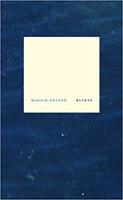 "Bluets" by Maggie Nelson
"Bluets" by Maggie Nelson A lyrical, philosophical, and often explicit exploration of personal suffering and the limitations of vision and love, as refracted through the color blue. With Bluets, Maggie Nelson has entered the pantheon of brilliant lyric essayists.
ISBN-10: 1933517409
ISBN-13: 978-1933517407
-
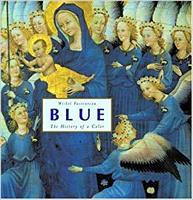 "Blue: The History of a Color" by Michel Pastoureau
"Blue: The History of a Color" by Michel Pastoureau Beautifully illustrated, Blue tells the intriguing story of our favorite color and the cultures that have hated it, loved it, and made it essential to some of our greatest works of art.
ISBN-10: 0691090505
ISBN-13: 9780691090504
-
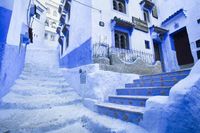 Chefcaouen, Morocco
Chefcaouen, Morocco The city of Chefchaouen, Morocco is packed with building painted in bright blue pigment. This was not the case when Chefchaouen was founded, but in the 1930's a large influx of Jews escaping the Nazi regime took refuge in Morocco and brought with them the tradition of painting buildings blue.
-
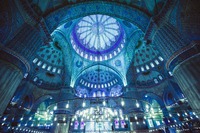 Sultan Ahmed Mosque
Sultan Ahmed Mosque Interior of the Blue Mosque in Istanbul, Turkey. The tiles are all hand painted with blue pigment.
-
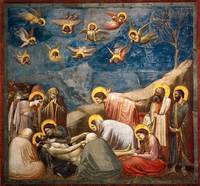 Lamentation of Christ
Lamentation of Christ The Lamentation of Christ is a painting found in the Scrovegni Chapel. It depicts the biblical scene of Jesus being taken down from the cross.
-
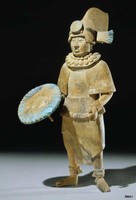 Jaina with War Banner
Jaina with War Banner Mayan clay statue of a Jaina warrior. The shield and headdress still hold traces of blue pigment.
-
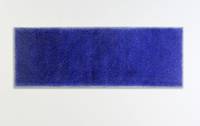 Avant-testo, 22-6-99, 1999
Avant-testo, 22-6-99, 1999 A part of the "Avant-testo" series of ballpoint pen calligraphy onto various materials such as canvas, paper, and polyester stretched over a wooden stretcher. Blank did a series of works that were entirely monochromatic done with ballpoint pen onto a surface, usually canvas. The mundane object of a blue ballpoint pen being used to create these large-scale monochromatic works is a maddening thought for the viewer. However, her process only emphasizes the color’s symbolism as a deep and complex infinity.
-
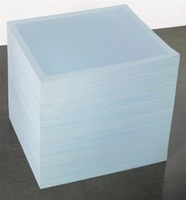 Untitled (Blue Mirror)
Untitled (Blue Mirror) This work was made to be distributed amongst the viewers. Participants are encouraged to take a sheet off the stack for themselves. Gonzalez-Torres chose the color blue because it is the color that most replicates the feeling of a void or emptiness. Therefore, it is the easiest for viewers to input their own feelings and thoughts into the color. This sheet of paper is supposed to act as a mirror for the people who take it home.
-
 Bleu I, II, III
Bleu I, II, III These three paintings are typically regarded and one triptych. The small and sparing figures, a few red and black dots, are composed so that the depth of the blue is overwhelming. The subject of the paintings are not the small figures, but the deep, almost vibrating, blue.
-
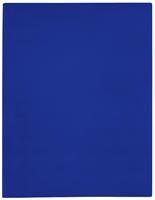 Blue Monochrome
Blue Monochrome Yves Klein worked almost exclusively in the color blue. He created many monochrome paintings in the pigment he created himself, International Klein Blue.
-
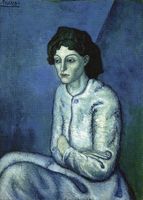 Femme aux Bras Croisés (Woman with Folded Arms)
Femme aux Bras Croisés (Woman with Folded Arms) Picasso's famous Blue Period took lace between the years of 1901 and 1904. During this period he painted almost exclusively in shades of blue. Often his subjects are depicted as sullen and depressed, looking away from the viewer.
-
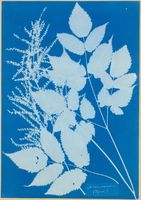 Spiraea Aruncus
Spiraea Aruncus Anna Atkins is one of the first documented women photographers, and is the first to create a book of photographs. She did not invent the cyanotype process, but is the one credited to its popularity. She used the chemical process to document British algae.
-
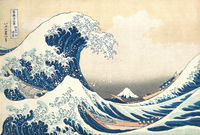 The Great Wave
The Great Wave The image depicts an enormous wave threatening three boats while Mount Fuji rises in the background. As in many of the prints in the series, it depicts the area around Mount Fuji under particular conditions, and the mountain itself appears in the background.
-
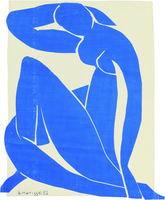 Blue Nude II
Blue Nude II Matisse worked on a series of three blue female nudes. All three are cutouts of a stark blue in the shape of a seated female.
-
 Girl with a Pearl Earring
Girl with a Pearl Earring the Girl With a Pearl Earring is one of the most well known paintings in the world. The focal point is the woman's pearl earring, but her blue turban gives her an air of royalty.
-
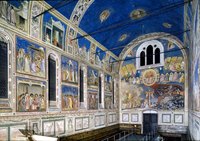 Scrovegni Chapel
Scrovegni Chapel The Scrovegni Chapel is in Padua, Italy. Giotto was both the architect and the painter of this famous chapel. It is well known for its extravagant use of blue, specifically in the ceiling.
-
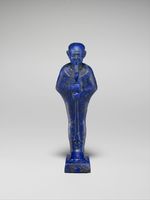 Cult Image of the God Ptah
Cult Image of the God Ptah This statuette depicts Ptah, the chief god of Egypt's capital city Memphis, who is easy to identify by his tight-fitting cap and enveloping shroud. Other iconographic details, such as the royal beard, the large and detailed broad collar, the scepter of merged "was" and "djed" signs, and a platform representing the hieroglyph for universal order, as well as the brilliant blue stone, communicate four important epithets: Lord of Lower Egypt, Master Craftsman, Lord of Truth, and Lord of the Sky.
 "A Field Guide to Getting Lost" by Rebecca Solnit Written as a series of autobiographical essays, A Field Guide to Getting Lost draws on emblematic moments and relationships in Rebecca Solnit's life to explore issues of uncertainty, trust, loss, memory, desire, and place. Solnit is interested in the stories we use to navigate our way through the world, and the places we traverse, from wilderness to cities, in finding ourselves, or losing ourselves. While deeply personal, her own stories link up to larger stories, from captivity narratives of early Americans to the use of the color blue in Renaissance painting, not to mention encounters with tortoises, monks, punk rockers, mountains, deserts, and the movie Vertigo. The result is a distinctive, stimulating voyage of discovery. ISBN-10: 9780143037248 ISBN-13: 978-0143037248
"A Field Guide to Getting Lost" by Rebecca Solnit Written as a series of autobiographical essays, A Field Guide to Getting Lost draws on emblematic moments and relationships in Rebecca Solnit's life to explore issues of uncertainty, trust, loss, memory, desire, and place. Solnit is interested in the stories we use to navigate our way through the world, and the places we traverse, from wilderness to cities, in finding ourselves, or losing ourselves. While deeply personal, her own stories link up to larger stories, from captivity narratives of early Americans to the use of the color blue in Renaissance painting, not to mention encounters with tortoises, monks, punk rockers, mountains, deserts, and the movie Vertigo. The result is a distinctive, stimulating voyage of discovery. ISBN-10: 9780143037248 ISBN-13: 978-0143037248 "On Being Blue: A Philosophical Inquiry" By William H. Gass On Being Blue is a book about everything blue—sex and sleaze and sadness, among other things—and about everything else. It brings us the world in a word as only William H. Gass, among contemporary American writers, can do. ISBN-10: 1590177185 ISBN-13: 978-1590177181
"On Being Blue: A Philosophical Inquiry" By William H. Gass On Being Blue is a book about everything blue—sex and sleaze and sadness, among other things—and about everything else. It brings us the world in a word as only William H. Gass, among contemporary American writers, can do. ISBN-10: 1590177185 ISBN-13: 978-1590177181 "Bluets" by Maggie Nelson A lyrical, philosophical, and often explicit exploration of personal suffering and the limitations of vision and love, as refracted through the color blue. With Bluets, Maggie Nelson has entered the pantheon of brilliant lyric essayists. ISBN-10: 1933517409 ISBN-13: 978-1933517407
"Bluets" by Maggie Nelson A lyrical, philosophical, and often explicit exploration of personal suffering and the limitations of vision and love, as refracted through the color blue. With Bluets, Maggie Nelson has entered the pantheon of brilliant lyric essayists. ISBN-10: 1933517409 ISBN-13: 978-1933517407 "Blue: The History of a Color" by Michel Pastoureau Beautifully illustrated, Blue tells the intriguing story of our favorite color and the cultures that have hated it, loved it, and made it essential to some of our greatest works of art. ISBN-10: 0691090505 ISBN-13: 9780691090504
"Blue: The History of a Color" by Michel Pastoureau Beautifully illustrated, Blue tells the intriguing story of our favorite color and the cultures that have hated it, loved it, and made it essential to some of our greatest works of art. ISBN-10: 0691090505 ISBN-13: 9780691090504 Chefcaouen, Morocco The city of Chefchaouen, Morocco is packed with building painted in bright blue pigment. This was not the case when Chefchaouen was founded, but in the 1930's a large influx of Jews escaping the Nazi regime took refuge in Morocco and brought with them the tradition of painting buildings blue.
Chefcaouen, Morocco The city of Chefchaouen, Morocco is packed with building painted in bright blue pigment. This was not the case when Chefchaouen was founded, but in the 1930's a large influx of Jews escaping the Nazi regime took refuge in Morocco and brought with them the tradition of painting buildings blue. Sultan Ahmed Mosque Interior of the Blue Mosque in Istanbul, Turkey. The tiles are all hand painted with blue pigment.
Sultan Ahmed Mosque Interior of the Blue Mosque in Istanbul, Turkey. The tiles are all hand painted with blue pigment. Lamentation of Christ The Lamentation of Christ is a painting found in the Scrovegni Chapel. It depicts the biblical scene of Jesus being taken down from the cross.
Lamentation of Christ The Lamentation of Christ is a painting found in the Scrovegni Chapel. It depicts the biblical scene of Jesus being taken down from the cross. Jaina with War Banner Mayan clay statue of a Jaina warrior. The shield and headdress still hold traces of blue pigment.
Jaina with War Banner Mayan clay statue of a Jaina warrior. The shield and headdress still hold traces of blue pigment. Avant-testo, 22-6-99, 1999 A part of the "Avant-testo" series of ballpoint pen calligraphy onto various materials such as canvas, paper, and polyester stretched over a wooden stretcher. Blank did a series of works that were entirely monochromatic done with ballpoint pen onto a surface, usually canvas. The mundane object of a blue ballpoint pen being used to create these large-scale monochromatic works is a maddening thought for the viewer. However, her process only emphasizes the color’s symbolism as a deep and complex infinity.
Avant-testo, 22-6-99, 1999 A part of the "Avant-testo" series of ballpoint pen calligraphy onto various materials such as canvas, paper, and polyester stretched over a wooden stretcher. Blank did a series of works that were entirely monochromatic done with ballpoint pen onto a surface, usually canvas. The mundane object of a blue ballpoint pen being used to create these large-scale monochromatic works is a maddening thought for the viewer. However, her process only emphasizes the color’s symbolism as a deep and complex infinity. Untitled (Blue Mirror) This work was made to be distributed amongst the viewers. Participants are encouraged to take a sheet off the stack for themselves. Gonzalez-Torres chose the color blue because it is the color that most replicates the feeling of a void or emptiness. Therefore, it is the easiest for viewers to input their own feelings and thoughts into the color. This sheet of paper is supposed to act as a mirror for the people who take it home.
Untitled (Blue Mirror) This work was made to be distributed amongst the viewers. Participants are encouraged to take a sheet off the stack for themselves. Gonzalez-Torres chose the color blue because it is the color that most replicates the feeling of a void or emptiness. Therefore, it is the easiest for viewers to input their own feelings and thoughts into the color. This sheet of paper is supposed to act as a mirror for the people who take it home. Bleu I, II, III These three paintings are typically regarded and one triptych. The small and sparing figures, a few red and black dots, are composed so that the depth of the blue is overwhelming. The subject of the paintings are not the small figures, but the deep, almost vibrating, blue.
Bleu I, II, III These three paintings are typically regarded and one triptych. The small and sparing figures, a few red and black dots, are composed so that the depth of the blue is overwhelming. The subject of the paintings are not the small figures, but the deep, almost vibrating, blue. Blue Monochrome Yves Klein worked almost exclusively in the color blue. He created many monochrome paintings in the pigment he created himself, International Klein Blue.
Blue Monochrome Yves Klein worked almost exclusively in the color blue. He created many monochrome paintings in the pigment he created himself, International Klein Blue. Femme aux Bras Croisés (Woman with Folded Arms) Picasso's famous Blue Period took lace between the years of 1901 and 1904. During this period he painted almost exclusively in shades of blue. Often his subjects are depicted as sullen and depressed, looking away from the viewer.
Femme aux Bras Croisés (Woman with Folded Arms) Picasso's famous Blue Period took lace between the years of 1901 and 1904. During this period he painted almost exclusively in shades of blue. Often his subjects are depicted as sullen and depressed, looking away from the viewer. Spiraea Aruncus Anna Atkins is one of the first documented women photographers, and is the first to create a book of photographs. She did not invent the cyanotype process, but is the one credited to its popularity. She used the chemical process to document British algae.
Spiraea Aruncus Anna Atkins is one of the first documented women photographers, and is the first to create a book of photographs. She did not invent the cyanotype process, but is the one credited to its popularity. She used the chemical process to document British algae. The Great Wave The image depicts an enormous wave threatening three boats while Mount Fuji rises in the background. As in many of the prints in the series, it depicts the area around Mount Fuji under particular conditions, and the mountain itself appears in the background.
The Great Wave The image depicts an enormous wave threatening three boats while Mount Fuji rises in the background. As in many of the prints in the series, it depicts the area around Mount Fuji under particular conditions, and the mountain itself appears in the background. Blue Nude II Matisse worked on a series of three blue female nudes. All three are cutouts of a stark blue in the shape of a seated female.
Blue Nude II Matisse worked on a series of three blue female nudes. All three are cutouts of a stark blue in the shape of a seated female. Girl with a Pearl Earring the Girl With a Pearl Earring is one of the most well known paintings in the world. The focal point is the woman's pearl earring, but her blue turban gives her an air of royalty.
Girl with a Pearl Earring the Girl With a Pearl Earring is one of the most well known paintings in the world. The focal point is the woman's pearl earring, but her blue turban gives her an air of royalty. Scrovegni Chapel The Scrovegni Chapel is in Padua, Italy. Giotto was both the architect and the painter of this famous chapel. It is well known for its extravagant use of blue, specifically in the ceiling.
Scrovegni Chapel The Scrovegni Chapel is in Padua, Italy. Giotto was both the architect and the painter of this famous chapel. It is well known for its extravagant use of blue, specifically in the ceiling. Cult Image of the God Ptah This statuette depicts Ptah, the chief god of Egypt's capital city Memphis, who is easy to identify by his tight-fitting cap and enveloping shroud. Other iconographic details, such as the royal beard, the large and detailed broad collar, the scepter of merged "was" and "djed" signs, and a platform representing the hieroglyph for universal order, as well as the brilliant blue stone, communicate four important epithets: Lord of Lower Egypt, Master Craftsman, Lord of Truth, and Lord of the Sky.
Cult Image of the God Ptah This statuette depicts Ptah, the chief god of Egypt's capital city Memphis, who is easy to identify by his tight-fitting cap and enveloping shroud. Other iconographic details, such as the royal beard, the large and detailed broad collar, the scepter of merged "was" and "djed" signs, and a platform representing the hieroglyph for universal order, as well as the brilliant blue stone, communicate four important epithets: Lord of Lower Egypt, Master Craftsman, Lord of Truth, and Lord of the Sky.